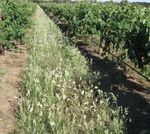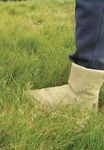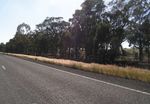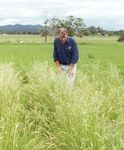TUSSOCKS, SPEARS, WALLABIES, 'ROOS - A DREAMTIME?
←
→
Page content transcription
If your browser does not render page correctly, please read the page content below
TUSSOCKS, SPEARS, WALLABIES,
‘ROOS - A DREAMTIME?
Story: Ian Chivers, Native Seeds Pty Ltd
Australian Grasses European origins and tend to die out after one or two years. Some
There is such a wide array of grass species available for big advantages over introduced species include a lower water
landscaping and turf why even consider Australian native grasses? requirement for growth, no need for lime or fertiliser to survive and
They’re all just clumps anyway! I’m busy – it’s all too hard! they don’t require resowing after drought, heat or fire.
How many native grasses are there anyway? Native grasses are available in an array of shapes and sizes, from
the well-known clump plants like Tussock Grass (Poa labillardieri)
Years of misinformation and misunderstanding feed our reluctance
through very short lawn types to huge bamboo-like types. There
to use or recommend native grasses, regardless of their possible
are around 1200 species of native grasses in Australia and each
advantages and applications. There are many really good reasons
would have developed many distinct ecotypes, so the range of
to include native grasses in your landscaping specifications, so let
germplasm available is huge and largely unexplored.
me give you some confidence in their use and some guidelines
about how to, and how not to, specify them. As this is such As a result of existing in our Australian environment across this
a potentially huge subject, I’ll have to limit myself to Southern entire continent for so long, there is a type of grass for virtually
Australia. For those in the northern part of Australia, well, maybe any desired purpose - from salt-spray affected alkaline soils to
that can be the topic of a follow-up article. shaded sites or cracking clay soils. With careful site description
you can find a native grass for nearly all of your site conditions and
Why use Native Grasses? landscape requirements.
Native grasses have been in Australia for millions of years and
consequently have adapted to Australian conditions - frequent What are Some of the Likely Types?
drought, high summer temperatures, low fertility and acidic, as There are six grasses commonly found in southern Australia - only
well as old and shallow, soils. There are many types and the a small sample of the 600 or so species found in this area.
conditions in which they have developed are highly varied, but we
Within this group of six grasses are four cool-season types – those
can make some generalisations. They have significant adaptational
that establish in the cooler months, grow actively in spring, and
advantages over the introduced species, which frequently have
1. Front garden designed by AILDM member
Georgina Martyn of Bold Simplicity. Native
Seed grasses are suitable in a domestic
context - this lawn is Griffin Weeping
Grass (Microlaena stipoides var Griffin)
which has been selected for the Royal
Botanic Gardens’ exhibit at Chelsea next
year. This lawn had not been mowed for
some months at the time of this photo and
has adopted a ‘meadow’ appearance.
2. Themeda triandra (Kangaroo Grass) seed
head forms throughout summer on stems
about 500mm with dark nodes. 1
12 landscape outlookflower over summer. There are also two warm-season grasses –
those that establish in the warmer months, grow actively over the
summer, and usually go dormant in the winter. These are known
for their drought tolerance.
Cool-season Types
Microlaena stipoides (Weeping Grass)
This grass is a natural turf-forming grass. It is highly shade
tolerant, has a very soft texture, is very persistent once
established, and can be mowed close for a lawn or left uncut for
a calf-height meadow appearance. It produces very high quality
turf and indeed the variety ‘Griffin’ will be used as a fine lawn
in the Royal Botanic Gardens (Melbourne) exhibit in the 2011
Chelsea Garden Show. Once established (and it grows best on
reasonably high organic content soils) it is very hardy and resilient
after drought.
Austrodanthonia spp. (Wallaby grasses)
There are 32 native species of Austrodanthonia and they vary
substantially in height, leaf texture and leaf width. Some species
such as A. carphoides are very small with mature plants not
growing taller than 50 mm, while others such as A. tenuior can
grow up to 1.2 m tall. They have different soil preferences and
tolerances to factors such as salinity and soil acidity. So simply
saying that you want an Austrodanthonia type for your landscape
is not sufficient - more detail is needed. It is like saying that you
want a gum tree for the job. For specifications you need to define
what it is you want from the wallaby grass – a tall accent plant, a
short and hardy ground cover or a hard-wearing lawn cover.
Poa spp. (Tussock grasses)
These grasses, and particularly Poa labillardieri (Large Tussock
Grass), have been used extensively in landscaping in southern
Australia - but sadly often incorrectly. While they can look good
for a year or so on batters and traffic islands, they will eventually
die under these conditions. Designers need to bear in mind
that these grasses originate in cool, wet, almost swampy areas
and that they will not survive well in dry, harsh conditions. There
are many better alternatives within the native grasses for these 2
locations.
When well used they can be attractive and provide that upright,
YOUR QUESTIONS ANSWERED
tall, structural element that is desired in many landscapes. They
AILDM members can contact Native Seeds about all issues
survive best when used en masse rather than as single plants.
relating to native grasses and their establishment from seeds.
Austrostipa spp. (Spear grasses) They have been doing research and development into native
Once again there are many species that form the Austrostipas grasses for almost 25 years, so are able to offer you significant
and they can, like the Austrodanthonias, range from small to expertise.
quite tall. They do live up to their name and all have spear-
For a free copy of Australian native grasses – a manual for
type seeds that can stick into the fur of animals or the skin of
sowing, growing and using them by IH Chivers and KA Raulings,
people, so their siting in the landscape needs to take account of
or to go on the mailing list for further info on upcoming webinars,
this. They are all very hardy and withstand drought better than
newsletters and special offers by Native Seeds, contact
most other species. They live happily on very shallow soils and
enquiries@nativeseeds.com.au
produce very showy seedheads that remain on the plant for
some months after maturity.
summer 2011 13Warm-season Types Common Issues with Tender
Themeda triandra [syn T. australis] (Kangaroo Grass) Specifications for Native Grasses
Most of the issues with tender specifications could be relatively
This grass is probably the benchmark of Australian native grasses.
easily resolved by asking some expert advice prior to publication of
Interestingly, it also occurs naturally in nearby countries, but it is in
tender documentation. This would be time well spent and far easier
Australia that it has spread across the entire country. It occurs from
to do than face a contract dispute.
the alps to the coast - north, south, east and west - and from the
desert to the rainforests. It is amazing to think that one species of The common issues and their solutions are as follows:
any plant can occur across these environments, but it does. As
1. Inappropriate species choice. Check cultural requirements of
a consequence of its widespread nature there are many different
species and match them with site conditions, remembering that
forms, some of which have been developed into identifiable
just because a species occurs in an area does not mean that
varieties.
it occurs in the same type of conditions that you are working
Tangara Kangaroo Grass was developed by the CSIRO for with.
roadside applications where the need was for an attractive plant
2. Seed unavailable. Check if seed is available rather than listing
with relatively low biomass. This grass takes on a wonderful purple
all native grass species of an area without considering this first.
colour in the autumn and retains that colour until active growth
resumes in Spring. 3. Seed sowing rates too low. If you need a high density of plants,
then you need a high rate of seed application. If soil is laden
There are many types of Themeda triandra and I will mention only
with weeds a heavier rather than lighter seed sowing rate is the
one other as a contrast, the variety ‘Burrill’, which is taller, more
best rule.
leafy and does not have the same colour as ‘Tangara’.
4. Inappropriate timing of seed application. While it is not always
Bothriochloa macra (Redgrass)
possible to have the landscaping occur when the conditions
This grass is the original “grows on the smell of an oily rag” grass. are right for germination, options should be provided for
It loves cracking clay soils, will provide grass cover under drought autumn/winter sowing operations and spring/summer sowing.
and does not mind shade.
3 4 5
3. Austrostipa densiflora (Foxtail Spear Grass) was sown on a roadside in northern Victoria for strongly persistent grass cover. Attractive flower in dense compact panicle on stem up to 1m.
4. Seedhead of Austrodanthonia richardsonii var Hume. Hume Wallaby Grass is highly persistent on very shallow soils and requires minimal fertiliser. Once established this grass can be mowed infrequently and needs little other
maintenance. It is useful for roadside verges and for lawns if sown at high density.
5. Intermediate species of Wallaby Grass, Austrodanthonia geniculata var Oxley. Selected for hardiness and longevity as well as seed production. Tufted perennial that remains green throughout the year.
14 landscape outlook6
6. This lawn shows how well Microlaena stipoides grows under heavy shade.
Note the numerous leaves and sticks deposited on the lawn over a long period
showing how this grass does not grow tall and require constant mowing, yet still
has good even coverage and colour.
7. A ustrodanthonia bipartita var Bunderra (Bunderra Wallaby Grass) produces
significant amounts of foliage year round.
7
8 9
8. Wallaby Grass planted in rows amongst
vines.
9. Austrostipa scabra (Rough Spear Grass)
which occurs widely through southern
Australia and is frequently found on
roadsides. Flowers with purple colouration
on stems up to 500mm.
10. T hemeda triandra ‘Burrill’. Taller and more
leafy than ‘Tangara’ and not as purple
10 in colour.
summer 2011 155. Provenance boundaries. The use of very tight provenance
boundaries is a technique that has been borrowed from
revegetation works involving trees and shrubs. All the scientific AUSTRALIAN NATIVE GRASSES
studies indicate that these boundaries are not appropriate Cool-season Types
for grasses. For more information on this, the Native Seeds • Microlaena stipoides (Weeping Grass): a natural turf-
website links to an interview with Prof. Wal Whalley. forming grass, highly shade tolerant, soft texture, very
persistent once established, can be mowed close for
6. Inappropriate seed mixes. Some seed mixes that are called
a lawn or left uncut
‘Native Grass Mix’ are often dominated by annual and perennial
ryegrass and have as little as 5% native grass content. Mixes • Austrodanthonia spp. (Wallaby grasses): 32 native
such as these never provide a native grass cover. species, vary substantially in height, leaf texture and
leaf width, also have different soil preferences and
Summary tolerances, suit a wide range of situations
There are many, many species of Australian native grasses that
are suited to lawn and landscape applications, and most are • Poa spp. (Tussock grasses): best used in mass
rarely considered. Seed supplies, sowing methods, agronomic planting in cool, wet, almost swampy conditions,
knowledge and success rates have improved dramatically don’t do well in dry, harsh situations (may look good
over recent years so there is no reason to have any ‘fear of the for a year or so but ultimately will not survive)
unknown’ about these grasses. Instead, there are opportunities • Austrostipa spp. (Spear grasses): many species that
to provide distinctive and impressive landscapes featuring their range from small to quite tall, all are very hardy and
splendour by just following recommended methods of use. withstand drought better than most other species,
happy in very shallow soils, showy seedheads
Warm-season Types
• Themeda triandra [syn T. australis] (Kangaroo Grass):
benchmark of Australian native grasses, occurs
from alps to coast - north, south, east and west –
decorative seedheads, seasonal colour, adaptability
and low maintenance make it an exceptional plant for
landscaping and revegetation
• Bothriochloa macra (Redgrass): the original “grows
11
on the smell of an oily rag” grass, loves cracking clay
soils, will provide grass cover under drought and does
11. Mature height of Griffin Microlaena in a seed production paddock where it receives both not mind shade
irrigation and fertilizer. Clearly it does not grow very high, but has a thick and dense coverage
closed to the ground. It was selected for turf use by the University of New England.
16 landscape outlookYou can also read



























































